
Cuneiform tablet

Cave painting

Socrates


Old Testament Egyptian Book of the Dead
Albert's Unique World History
This page was last updated on 6-2-22 and modified on 7-30-19
Copyright Albert Fried-Cassorla
|
Cuneiform tablet |
Cave painting |
Socrates |
Old Testament Egyptian Book of the Dead |
Quick links: Puabi - 2600 BCE 1750 BCE Hammurabi 447 BCE - The Parthenon 1840 - Women's Rights in the U.S.
| Purpose:
Hello! The purpose of building this unique view of World History is to share moments and objects in the history of our universe that I find fascinating -- and that I hope you will enjoy! It is not intended to provide an encyclopedic view. Many wonderful sources for that exist elsewhere. Instead, I hope that you will find here some objects, moment and stories that are exciting, horrendous, amazing or beautiful. Perforce, that cannot include everything. So welcome to my unique collection!
Albert Fried-Cassorla albfcc@icloud.com |
More Quick links:
#Massacres Massacres in Art and Poetry
Brief Timeline
5300 BC
|
The Universe
13.8 billion years ago
|
NOTES: The Universe began in the Big Bang. |
|
Born 6 billion years ago |
Earth is born
|
|
2.1 billions years ago [1] |
Cells with a nucleus
|
|
521 million years ago -
Early Cambrian Period |
Trilobites lived |
|
220 millions years ago |
First mammals |
|
75 million years ago |
First primates |
| 55 million years ago | |
|
15 million years ago |
Great apes - hominids humans, chimpanzees, gorillas, and orangutans |
|
12 million years ago |
Pre-humans, Australopithecenes, branch off from apes.[i] |
|
8 million years ago |
Homininae - Humans, chimpanzees, and gorillas |
| 7 MYA approx | "Toumai," homininae, closest relative of ours near divergence between pre-humans and apes. Discovered in Chad. Source: https://en.wikipedia.org/wiki/Sahelanthropus
|
|
4.5 million years ago |
Homo begins using tools |
| 2.4 MYA | Australopithecus anamensis found near Lake Rudolf * DK Timelines of World history, p. 10 |
|
2.5 million years ago |
PALEOLITHIC ERA begins, lasting until 10,000 BC.[2] Genus homo begiins. |
|
2 MYA |
Homo erectus appears. - earliest pre-humans appear - hominids but not homo sapiens History's Timeline, by Jean Toomer, Ann Kramer, and Theodore Rowland, Crescent Books, 1981, p. 8
|
|
250 MYA |
Lucy discovered
|
|
Pleistocene Era
|
|
|
46,000 BC -
|
earliest Cave Paintings at El Castillo, Spain |
|
40,000 BC |
Last Ice Age. Arrival of Cro-Magnon Man. History's Timeline, by Jean Toomer, Ann Kramer, and Theodore Rowland, Crescent Books, 1981, p. 8 |
|
35,000 BC |
CAVE PAINTINGS at Chauvet |
|
30,000 BC |
Neanderthal Man dies out. History's Timeline, by Jean Toomer, Ann Kramer, and Theodore Rowland, Crescent Books, 1981, p. 8 |
|
15,300 BC approx, |
CAVE PAINTINGS at Lascaux [3] |
|
9,000 BC |
First town, Catalhoyuk, Turkey, founded[4] |
|
8,400 BC |
First pet dog. History's Timeline, p. 8 |
|
8,000 BC |
Writing - Mesopotamians begin using cuneiform |
|
10,000 or 6000 - 2800 BC |
NEOLITHIC period begins. Farming introduced. In the Neolithic Period, Ice man lived.
|
| 5300 BCE | Writing - Tartaria tablets found in Romania[5] |
|
3500 BC |
MESOPOTAMIA: Wheel invented |
|
3100 BC |
Writing - first written records |
|
3000 BC |
CHINA: Abacus invented, "first computer" or calculator |
|
2300 - 1900 BCE
|
Early Helladic period |
|
1,900 BCE |
Theseus said to have lived in Crete and fought the Minotaur
|
|
1500 |
Phonecians invent the alphabet |
|
1900 BCE |
JUDAISM: Unconfirmed religious literature says that Judaism began near or in Hebron at the Cave of the Patriarchs.[6] The Old Testament may have been written then or as late as 300 BCE. |
|
1750 BCE |
Code of Hammurabi Written. See also on this page: Hammurabi |
| 1400 BCE | FUNERARY BANQUET, TOMB of NEBAMUN, Egypt. One of the most delightful images I have seen in my art history course at Temple University is this one. You need to click on the link below and check out the study blue link within. These people from 1400 BCE in Thebes, Egypt are shown celebrating with flutes, food, and dance. The hair styles are similar one to the other but not exactly the same. I love to see such relaxed happiness portrayed from such a distant past! |
|
1213 BCE |
JUDAISM: Meneptah stele mentions Israel. Meneptah was thr son of Ramses/ Israeli history may go back to 1500. Israel begins in Canaan, corresponding roughly to modern Israel and Palestine. |
|
1275 - 1208 BCE |
EGYPT and JUDAISM: Jews may have had their exodus from Egypt. [7] |
|
776 BCE |
First Olympian games |
|
753 ? BCE |
Rome allegedly founded |
|
700 - BCE |
Hesiod composes poems about the Greek gods
|
|
725 B.C. |
Homer writes first poems |
|
650 |
First coins minted in Greece, in Anatolia |
|
624- 526 |
Thales lives, first Pre-Socratic, labels elements. materialists, non-mythological |
| 551-479 BCE | Confucius lived - great conservative Chinese philospher. Believed in the sanctity of laws, the state and traditions. |
| 590 (approx) to 531 BCE | Lao-Tse lived. He was a great Chinese philosoher and believer in the freedom of the spirit. His views are often contrasted with those of Confucius. He believed in a return to nature rather than a life of action. Source: https://en.wikipedia.org/wiki/Laozi#Taoism |
|
550 (circa) |
Peisistratos - a tyrant, becomes a populist. and overturns aristocrat |
|
539 |
Cyrus the Great Expands persian empire to east and west, giant. His tomb still exists in Iran. Protected by current Iranians. Zoroastrians is protected by the Iranians. Still has 300,000 adherents. |
|
509 - 27 BC |
Roman Republic established |
|
507-8 BC |
Cleisthenes helps establish democracy in Greece[8] |
|
490 |
Battle of Marathon |
|
470 - 399 |
Socrates lives - instruction by conversation; helped others realize their own values and knowledge of reality[9] |
|
480 |
Battles of Thermopylae & Salamis |
|
|
Battle of Salamis - Greeks pretend to be retreating. Capture and defeat the Persian fleet. |
|
451 BC |
ROME: Twelve Tables, early law |
| 447-432 BCE | GREECE: Parthenon's construction |
|
450 |
Atilla the Hun crosses the Rhine and sacks Orleans and other cities. |
|
431 |
Peloponnesian War - first outbreak of hostilities; Athens had 300 triremes, Sparta had 100[10] |
|
404 |
Peloponnesian War ends |
|
400 BC |
Greek Athlete from 400 BC approx., as show at the Metropolitan Museum of Art. See the large photo farther below. |
|
390 BC |
ROME: Gauls raid Rome, briefly |
|
367 BC |
ROME: 1 consul must be a plebian |
|
334 |
GREECE: Alexander the Great begins Persian campaign |
|
324 - 270 |
Zeno the Stoic lived - believed in participation in the world, civic duty, orderly cosmos / logic |
|
342 - 270 BC |
Epicurus - founder of Epicureanism. belief in reasonable pursuit of pleasure, avoiding politics, world is chaotic |
|
3rd century BC |
Library at Alexandria is built by Ptolemy - has 500,000 volumes, mainly papyrus scrolls |
|
300 BC |
GREECE: Euclid writes The Elements of Geometry JUDAISM: Old Testament may have been written. |
|
264 - 146 |
ROME: Punic wars with Carthage; fought at first over Sicily, then Spain; Rome absorbs Carthage. Hannibal takes elephants across the Alps & nearly defeats Rome. |
|
230 BC |
Dying Gaul statue completed, perhaps by Attalus of Pergamon, to celebrate victory possibly over Gaulish or Celtic people in Anatolia (Turkey)[11] |
|
|
|
|
|
|
|
197 - 159 BC |
Library at Pergamum built; parchment begins to replace papyrus in making books |
|
133-122 |
ROME: Reforms of the Gracchi |
|
107 - 86 |
ROME: Consulship of Marius |
|
82 - 79 |
ROME: Dictatorship of Sulla |
|
85 BC |
ROME: Sulla is appointed dictator; eben Caesar is on his list. Caesar is spare through efforts of his mom. |
|
73-71 |
ROME: Rebellion of Spartacus |
|
67 BC |
ROME: overtakes Judea |
|
60 BC |
ROME: Caesar, Crassus and Pompey form a triumvirate |
|
52 - 48 |
ROME: Struggle of Pompey and Caesar |
|
51 BC |
ROME: Caesar completes Gallic wars |
|
44 BC |
ROME: Caesar assassinated |
|
27 BC |
ROME: End of the Republic as Senate grants extraordinary powers to Octavian, who becomes Augustus; first EMPEROR; end of the REPUBLIC. |
|
|
|
|
14 - 37 AD |
ROME: Tiberius, a general is adopted |
|
37 - 41 |
ROME: Caligula (Gaius) thinks of himself as a god, is assasinnated |
|
41 - 54 |
ROME: Claudius, emperor, conquers Britain; after Caligula was assassinated; bribed Praetorian guard to make him emperor; running water established, extensive uses of arches and aqueducts; marries ambitious Agrapina (sp?); convinces Claudius to name a successor, Nero; poisoned by a mushroom |
|
54 - 68 |
ROME: NERO -Nero, loves plays and music, does not "fiddle" as Rome burns; since violin was not invented |
|
Date? |
CHRISTIANITY: Jesus Christ is crucified under Pontius Pilate, Herod. Augustus, emperor, was probably not aware. |
|
4 BC |
CHRISTIANITY: Jesus born in Galilee - endorsed later nu John the Baptist. Charismatic preacher. |
|
64 AD |
ROME: Rome burns. Nero is suspected, supposedly playing his lyre; confiscates burned land, 200 acres and makes Golden House, Domus Aureus, ; Nero has Christians blamed and burned. Aggrapina expects to co-rule with son, Nero; In 59 Aggrapina is killed by orders of Nero; 68 or 69ad, Nero is hunted. Throat slit by a slave, a suicide. "What an artist dies in me" By 104 AD, Domus Aurea is buried. |
|
69 - 79 |
ROME: VESPASIAN Vespasian, struggles with other generals and wins; suppresses Jewish rebellion; general from the East; On top of Domus Aurea, he uses that space to build the Coloseum. |
|
72 - 80 |
Jewish captives build the Coloseum. 160 ft tall. Tallest ancient structure. |
|
79 - 81 |
ROME: Titus inaugurates Coloseum; 5,000 animals slaughtered, th9usands of people die inside |
|
81 - 96 |
ROME: Domitian |
|
96 - 98 |
ROME: Nerva |
|
98 - 117 |
ROME: Trajan, from Spain, popular, expands empire to Romania or Dacia, Trajan's column
|
|
117 - 138 |
ROME: Hadrian, erects Hadrian's Wall in Britain; consolidation and fortification; loved Greek Culture; another Jewish rebellion; expelled Jews from Judea; destroys Solomon's temple; re-names Jerusalem ? |
|
138 - 161 |
ROME: Antoninus Pius- rewrites laws, good to slaves, "innocent until proven guilty is a phrase under his rule |
|
161 - 180 |
ROME: Marcus Aurelius and Verus - 6 - 7 million people killed by a disease, probably smallpox; Verus dies; population declines; Germanic tribes incursion; always defending the Danube. Believer in Stoicism. |
|
173 - 238 AD |
ROME: Maxiinmus Thrax, Emperor |
|
178 AD |
ROME: Magnificent head of an athlete, a copy of a Roman original |
|
177 - 192 |
ROME: Commodus, was a gladiator; Senate hates that; he is assassinated. |
|
245 - 311 |
ROME: Diocletian rules, divides empire into 4 parts |
|
379 - 395 |
ROME: Theodocius rules - divides empire into East and West halves. |
|
325 |
ROME: Constantine - Council of Nicea declares the Trinity to be true |
|
313 |
ROME: Constantine - declares Christianity legal |
|
400 AD |
ROME: Constantine establishes Constantinople (Istanbul) as capitol |
|
410 |
Goths : Alarics takes Rome |
|
439 |
VANDALS capture Carthage |
|
466-511 |
CLOVIS lives, rules, 488-511, unites the Franks. He is a Merovingian king. |
|
476 |
Non-Roman Odacer assumes title of King of Italy |
|
527 - 565 |
Justinian rules Eastern Empire. wants to reunite empire. Theodora is his queen, a courtesan but equal royal. She saves the empire. |
|
530 |
https://en.wikipedia.org/wiki/Dying_Gaulis born. |
|
523 |
Nica riots besIEge Justinian. |
|
533-534 |
Vandals invade |
|
537 |
Justinian orders building of the Hagia Sofia |
|
542 |
Pandemic - probably the Black Death. 100 million die. |
|
570 AD |
ISLAM: Muhammed born. |
|
610 - 632 AD |
ISLAM: Muhammad receives divine inspiration from Gabriel and receives the Qu'ran. (kORAN) |
|
610 APPROX |
Pope Gregory I (c 50 - 604), Introduces legitimacy of Purgatory and accepts donations to get relatives into heaven; introduces double monasteries |
|
610 APPROX |
MUSIC: Pope Gregory I (c 50 - 604), introduces Gregorian chant to worship |
|
700 approx. |
ARCHITECTURE: Mt. St. Michel built in Normandy, a monastery |
|
726 AD |
Eastern Emperor and head of church Leo III declares icons are not acceptable |
|
731 AD |
Venerable Bede established our modern system of years, BC, AD, etc. |
|
768 AD |
WRITING: Under Charlemagne, lower case letters are invented or popularizes; Carolingian miniscule. CHARLEMAGNE becomes first king of Holy Roman Empire. |
|
790 AD |
First female emperor, Irene; removes ban on icons |
|
800 AD |
Charlemagne gets title of Emperor of the West |
|
814 |
Louis the Pious r 814 - 843 - divides kingdom into Charles gets west Louis the German gets east, Moravia; west Francia goes to |
|
910 AD |
Clerical celibacy institutionalized in Cluny. Marriage becomes an official Christian sacrament, |
|
911 |
Rollo and Vikings get Normandy and settle down |
|
1000 |
CLIMATE: warming trend begins, lasts until 1600. |
|
1066 |
ENGLAND and FRANCE: Normans invade England. William the Conqueror is the first Norman King of England. King Harold repels the last Viking invasion. Battle of Hastings is a rout for Anglo Saxons. Oct 14, 1066, Anglo-Saxons are defeated. |
|
1079 |
Abelard born - famous philosopher logician and lover of Heloise. LITERATURE: Letters of |
|
1095 |
CRUSADES begin. First Crusade. JUDAISM; First victims are Jews. Bishops try to help. Pope Urban II is chief instigator of anti-semitism. Recaptures Antioch and Jerusalem, |
|
1095 |
SCI-TECH: Advent and popularization of horseshoes, wheelbarrows, watermills and windmills. |
|
1126 |
PHILOSOPHY: AVERROES is born, an Andalusian polymath. comments on Aristotle, |
|
1154 |
Henry II, King of England. Invades Ireland. |
|
|
|
|
|
|
|
|
|
|
1213 AD |
JUDAISM: Fourth Lateran Council - formalizes anti-semitism. |
|
1215 AD |
MAGNA CARTA signed by King John I at Runnymede; leads eventually to Parliament |
|
1198 - 1216 |
Pope Innocent III - Starts excommunication. Victims of heresy accusations are Jews, Christians, Cathars in southern France; Waldensians of Leon |
|
124 0AD |
Genghis Kahn and Mongols wipe out Kiev and most of Russia, mounted archers. Ruthlessly killed populations they conquered. |
|
1280 approx. |
Eyeglasses likely invented by Italians |
|
1300 - 1500 AD |
Black Death, from Mongolia / N. China > Yersinia Pestis |
|
1309 |
CHRISTIANITY: Babylonian captivity of Papacy in Avignon, France |
|
1315 - 1322 AD |
The Great Famine |
|
1337 -1443 AD |
ENGLAND and FRANCE: Hundred Years' War. Plantagenets battle French House of Valois Phillip VI for control of Edward III claims French throne. Longbow proves decisive. Joan, daughter, marries Pedro of Spain. |
|
1374 approx. |
PETRARCH publishes Il Canzionere, The Songbook, of 366 sonnets. These later inspire Shakespeare. |
|
1429 - 1431 AD |
ENGLAND and FRANCE: Career of Joan of Arc. Siege of Orleans, defeats English. Captured by Burgundians. Convicted of witchcraft and is burned at the stake at Rouen. |
|
1436 |
IL DUOMO finished, dome designed by Brunelleschi |
|
1450 |
GUTENBERG produces the Gutenberg Bible in Mainz. |
|
|
SCIENCE: Cannons become used. |
|
1453 AD |
ENGLAND: Reduced in France to only Calais. |
|
1453 |
TURKS capture Constantinople - Hungarian devises large cannons and sells it to Ottomans. |
|
1462 AD approx. |
RUSSIA: Ivan the Terrible builds the Kremlin Citadel, tries to modernize Russia; rids Russia or Mongols. Double eagle symbol adopted: Czar and church leadership. |
|
1480's |
BOTTICELLI's paints The Birth of Venus. |
|
1516 |
Sir Thomas More (1478 - 1535), writes "Utopia" in 1516; executed for not agreeing with Henry VIII's break with Rome |
|
1517 AD |
MARTIN LUTHER posts the 95 Theses. |
|
1545-1563 |
Council of Trent establishes papal supremacy, 7 sacraments. no compromise, affirming good works, celibacy, limits indulgences , ends simony, creates an index of banned books |
|
1554 |
Ignatius of Loyola creates constitution of the JESUITS. This order emphasizes learning and devotion to the Pope. |
|
1600 AD |
CLIMATE: mini ice age begins. |
|
|
|
|
|
|
|
|
|
|
1940 |
CAVE PAINTINGS at Lascaux discovered by 18 year old Marcel Ravidat[12] |
|
|
|
|
-
- - - 421 - Erechtheum is built ? - age of Perecles - Parthenon built 386 - Founding of Plato's Academy 336 - 333 - Alexander the Great rules "The World"
Aeschylus, Sophocles, Euripides The Old Testament - Books of Job, Genesis
New Testament
Middle ages - Everyman play
Dante's Dvine Comedy
Paradise Lost
Don Quixote
|
Other Civilizations
|
|
Shakespeare, Johnson |
|
|
19th Century Tolstoy Dickens Poe Thoreau
|
|
|
20th Century
Frost Eliot Steinbeck
|
|
|
8,000 BC - Homer's Odyssey 4,000 Cuneiform tablets appear
|
2,200 BC approx. - The Epic of Gilgamesh 1,800 BC - Egyptian Book of the Dead 450 BC - The Bible: Old Testament or Tanakh
|
700 BC - Archilochus of Paros, Greek, first lyric poet 630 approx - Sappho, Greek, lyric poet, loves both sexes 470 BC approx. - Socrates, no writings, develops philosophy through dialectic |
450 BC approx. - Greek plays of Aeschylus, Euripides, and Sophocles 414 BC - Aristophanes's comedy, The Birds - first comedy 380 BC - Plato lives, writes The Republic
|
13.8 billion years ago - The Big Bang explosion
For the wikipedia entry on this, visit HERE.
4.54 billion years ago - Planet Earth is born
|
550 Millions Years ago - trilobites lived in the Early Cambian Period Source: en.wikipedia.org/wiki/trilobite
|
| Photocredit: copyright Albert Fried-Cassorla |
HUMAN PREHISTORY
85 millions years ago - late Cretaceous period - Primates diverge from other mammals
7 MYA approx - "Toumai," homininae, closest relative of ours near divergence between pre-humans and apes. Discovered in Chad. Source: https://en.wikipedia.org/wiki/Sahelanthropus
(No image is reproduced here because rights information is confusing.)
4 million years ago - homind footprints - clay reproduction
These two footprints are powerful to me. even if they ar reproductions. I feel as though we are looking, however indirectly, at the ghostly residues of
our earliest ancestors. I envision them as African men who were walking on a lakeside beach.
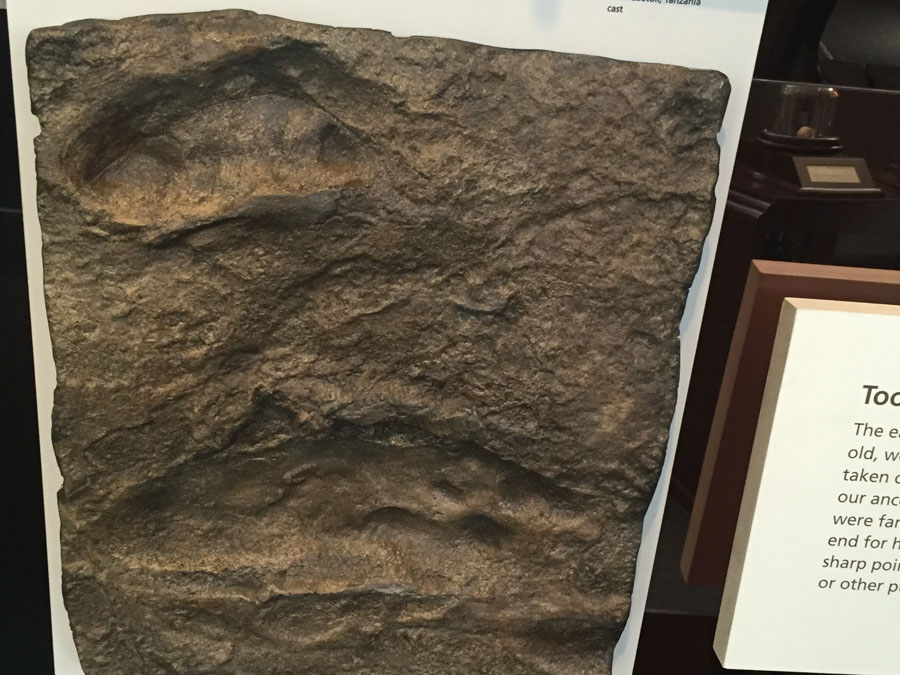
Source: Penn Museum - Photo by Albert Fried-Cassorla
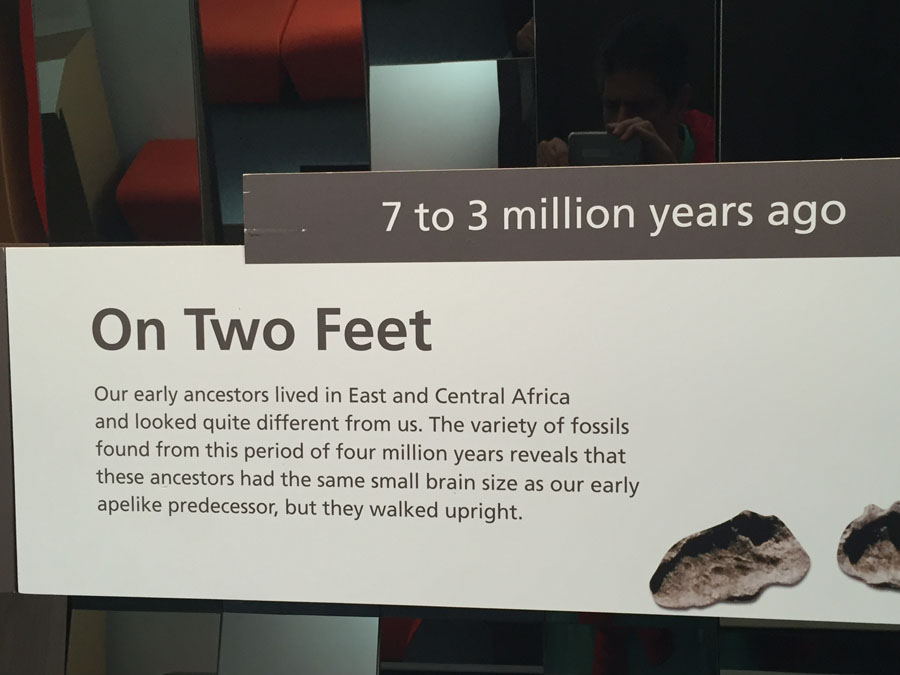

3.3 MYA - Selam (see text below) recreation - Our oldest homo ancestor. Source: https://en.wikipedia.org/wiki/Selam_(Australopithecus)
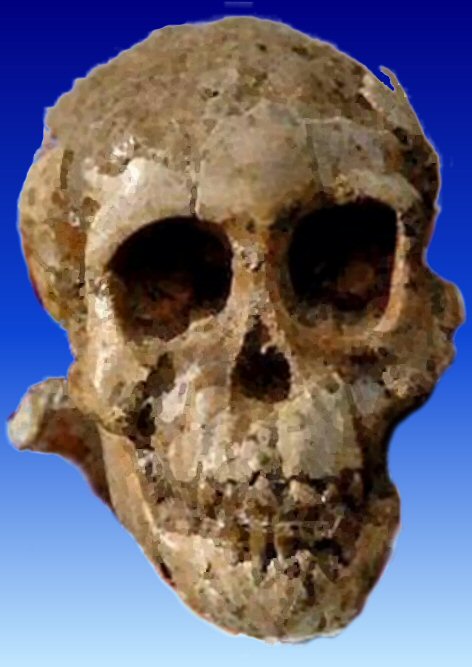
3.3 MYA -Selam (see text below) recreation - Our oldest homo ancestor. Source: https://en.wikipedia.org/wiki/Selam_(Australopithecus). Note the vertical angle above the eye sockets.
This indicates greater cranial a capacity. Not yet homo sapien.
3.3 MYA - Selam, (above) earliest known Australopithecus, found in Dikka, Ethipioa.
3 million years ago - early hominids, including australopithecus
Note the prominent brow ridge, which I had thought mainly pertained to Neanderthals. Also see now the upper skull has a smaller diameter than the eye-level
portion of the skull.
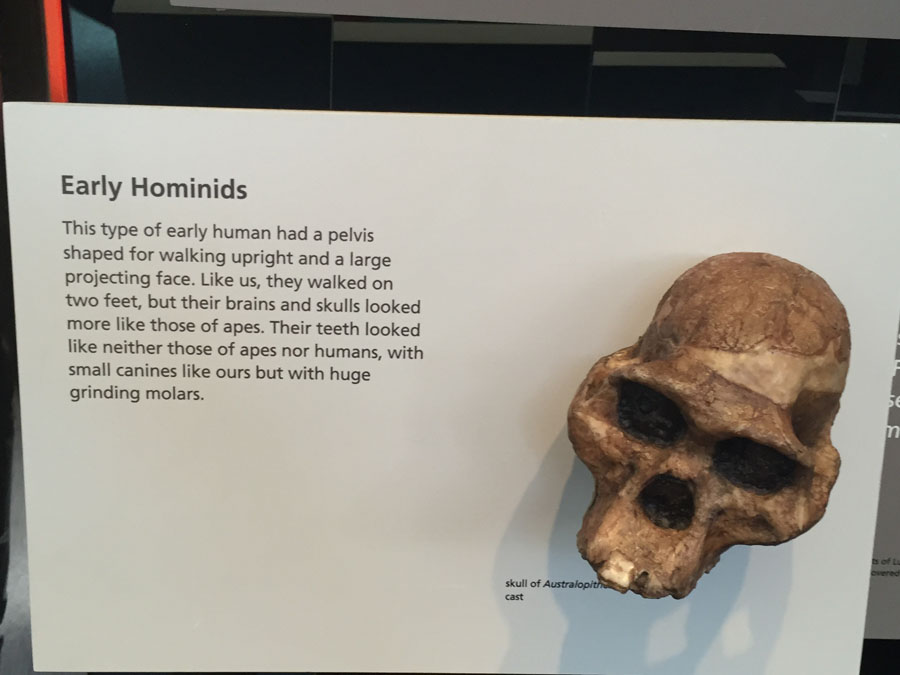
Source: Penn Museum - Photo by Albert Fried-Cassorla
2,400,000 BCE- Australopithecus anamensis found near Lake Rudolf * DK Timelines of World history, p. 10
1.8 million year ago - leaving Africa
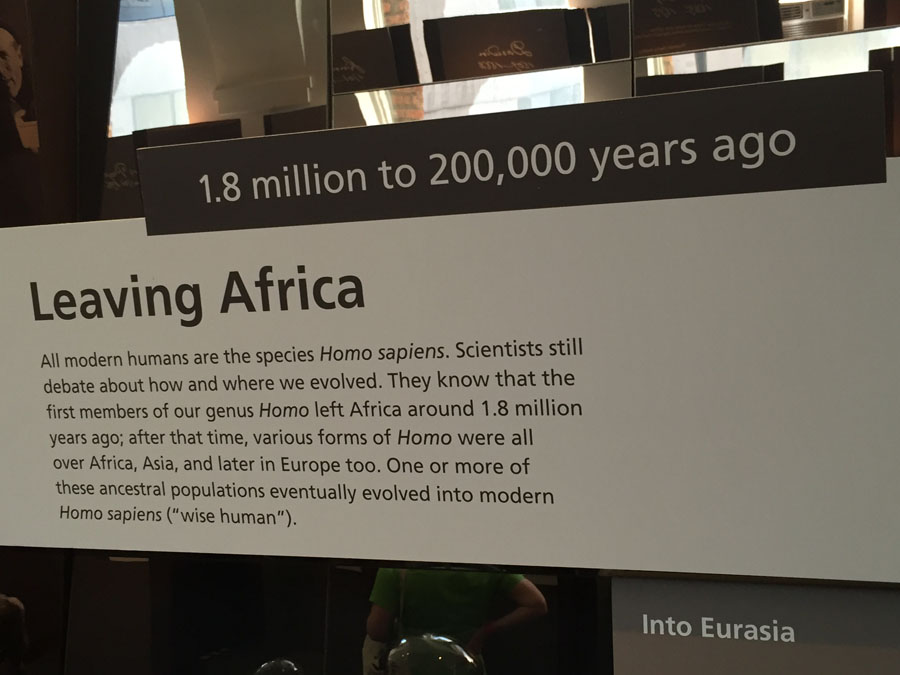
125,000 BCE - Neanderthals - a parallel hominid
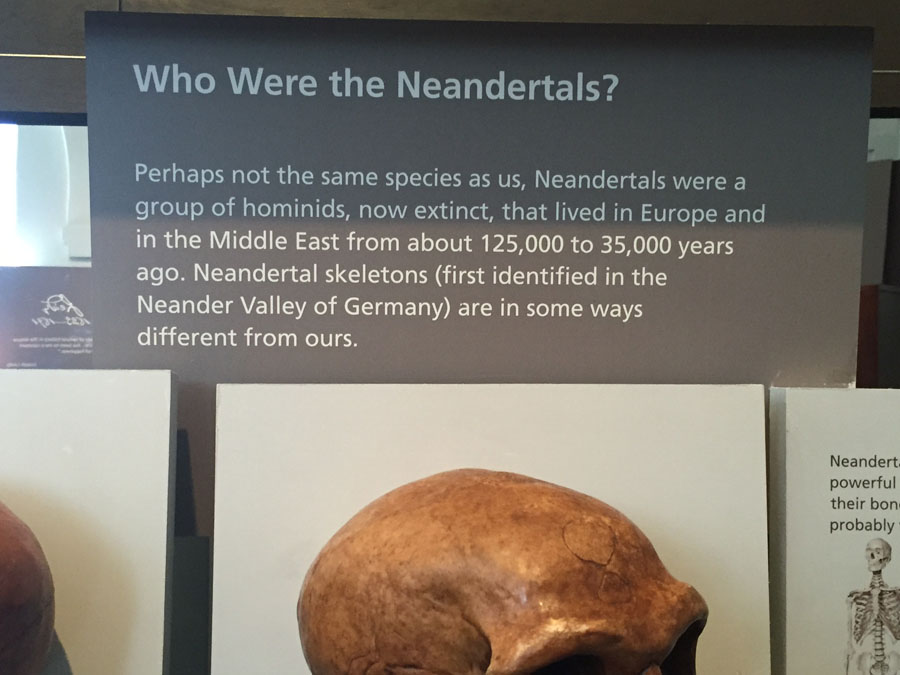
Neanderthal - We re always reminded to look at the prominent brow ridge/ But look at those teeth! They actually seem to be in pretty good shape.
And the cranial capacity seems large.

2600 BC - Princess Puabi of Ur in Sumeria
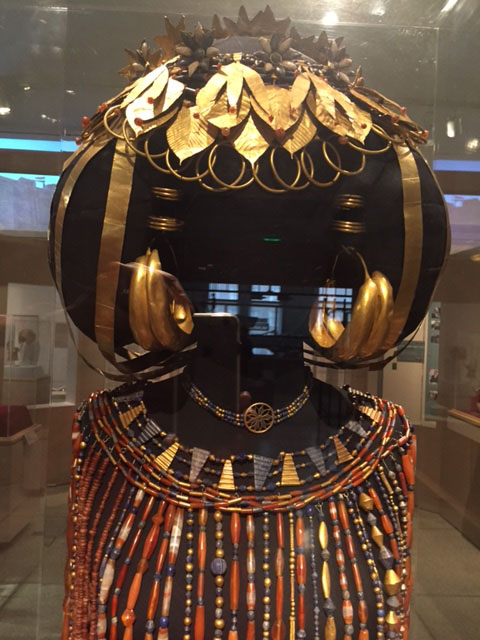 |
PUABI's headdress and necklace Note: This essay was written as fulfillment of an assignment in my Puabi was a QUEEN of UR, circa 2600 B.C.E. These magnificent artifacts are on display at the Penn Museum, where I visited today in a tour-assignment with my Art History Class at Temple University. I was drawn to these objects by their elaborate and lovely craftsmanship. Also, I was impressed that these ornaments belonged to a powerful and perhaps beautiful woman from so long ago. Communication: the beauty and craftsmanship convey a sense of importance to those who behold these objects. That is a form of non-verbal communication. Story: The story insofar as I can tell, is this: "I am a powerful woman. The difficult and exacting work needed to produce these objects that I wear shows that I am respected. Also, they show that I am a person with a keen esthetic sense." Style: The style of this headdress and necklace are based in part on natural motifs, such as leaves, plus geometric patterns. Not much is known about Puabi, although she is presumed to have been a queen. That assumption is based on her regal trappings, her not being shown with her husband, and by her elaborate tomb. Ur was one of the oldest cities in the history of humanity. Particularly beautiful to me are the gold leaves and the lovely beads. I hope you can see it all clearly, especially in the close-up photo. This was my fifth visit to the Museum, and I was enchanted during the entire 2-hour stay. Hope you enjoy these images!
|
HASHEPSUT 1507 - 1458 BCE
July 30, 2019
Egyptian history one. Today, I attended a mini lecture at the Penn museum about Hashepsut, an amazing Queen who lived and ruled a millennium and a half ago.
She is possibly the greatest woman to have lived in her era, or even more significantly one of the greatest women of all time.
She paved the way for a humanistic version of Egypt, including advances in agriculture, botany, inter-people relations and more. Her monuments were extensive. She was no angel, since she also conducted various wars. However, her reign peaceful. Her successor, Thutmose
III, abolished most of her inscriptions, trying to erase her from history.
The talk was fascinating!
(Note to Albert: add photos from Indexfiles)
https://en.wikipedia.org/wiki/Hatshepsut
| 1750 BCE - Stele of Hammurabi's Code of Laws |
|
The following photos were taken by me, Albert Fried-Cassorla. at the Penn Museum of the University of Pennsylvania. I chose to include this object because it is -- iconic -- included in most world history textbook. And I have also chosen it because it symbolized the rule of law, as one of the first constitutions. The rule of law can be cruel and unjust, of course. Witness one part of the Code: "An eye for an eye, a tooth for a tooth." Nonetheless, the Code and this stele represent an unique moment in history.
|
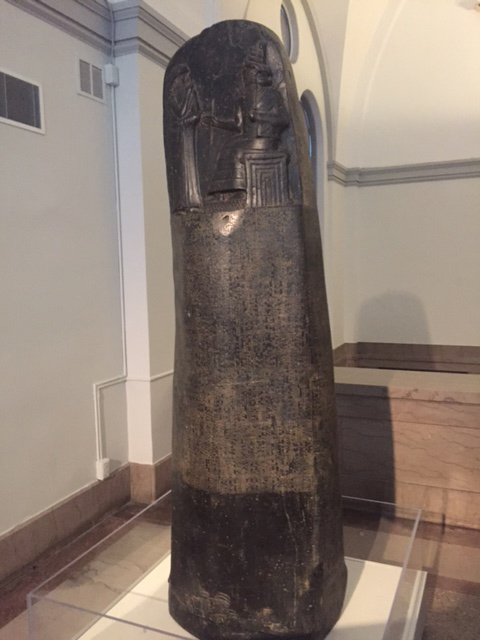 |
|
This shows a replica of the original Stele of the Code of Hammurabi from Ancient Assyria.
|
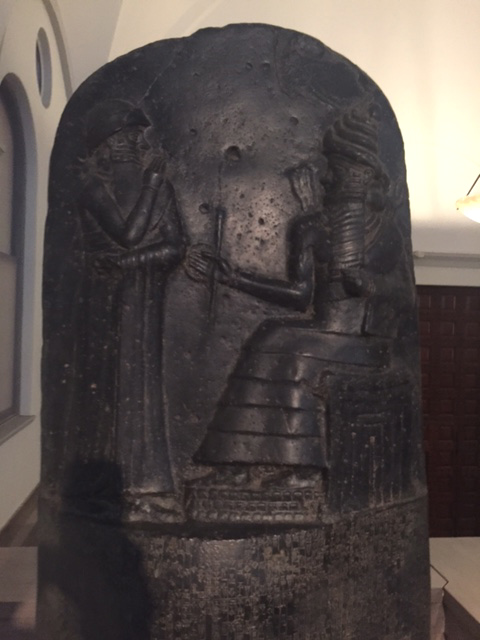 |
|
Hammurabi here is on the left. He is receiving a royal insignia from an official or religious figure.
|
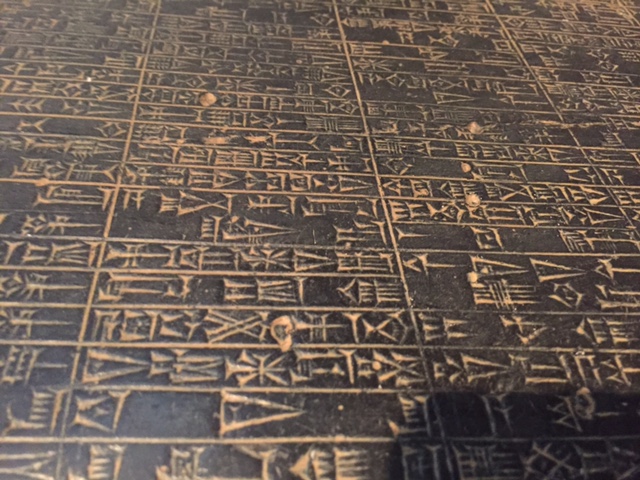 |
| Cuneiform writing on the stele replica. |
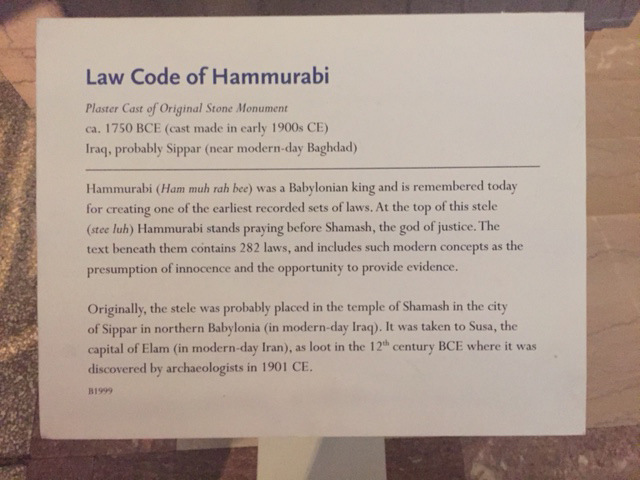
Learn more about the Code of Hammurabi at: https://en.wikipedia.org/wiki/Code_of_Hammurabi
551- 479 BCE - Confucius lives - great conservative Chinese philospher. Believed in the sanctity of laws, the state and traditions. Source: https://en.wikipedia.org/wiki/Confucius

Photo credit: Copyright Albert Fried-Cassorla
Nature! Respected, and revered by Lao-Tze...
590 (approx.) to 551 BCE - Lao-Tse lived. He was a great Chinese philosoher and believer in the freedom of the spirit. His views are often contrasted with those of Confucius. He believed in a return to nature rather than a life of action.
Source: https://en.wikipedia.org/wiki/Laozi#Taoism
Amazons - late 4th Century B.C
Go to haaretz.com and search for Tomb With Three Generations of ‘Amazon’ Warrior Women Found in Russia or
https://www.haaretz.com/archaeology/.premium.MAGAZINE-amazon-warrior-women-russia-archaeology-scythian-greece-1.8327358
447-432 BCE: The Parthenon is constructed. Like many people, I consider this one of humanity's
most magnificent buildings, a testament to civilization's ability to endure. Feel free to visit my Greece web site for more
information, including videos of my visit. Click HERE.
.jpg)
Photo credit and copyright: Albert Fried-Cassorla
400 BC - From my journey to the Metropolitan Museum of art a few weeks ago… This head of an athlete is a Roman copy circa 170,?based on a Greek bronze from the 400s BC.
I think it is magnificent. I can't imagine that the bronze original was as beautiful, given that the white and dark surfaces are so expressive. This athlete was probably a winner, according to the nearby sign. The description refers to his deeply drilled hair.I imagine that the drilling refers to the tight curls. In any case we have an amazing representation of an actual person, skillfully re-created from 2400 years ago. Stunning!😉


0 A.D - Antikythera mechanism -
Massacres as subjects of Art and Poetry
a web portion by Albert Fried-Cassorla, created May 23, 2022
Massacres are by definition horrible events. They typically involve the worst things we can imagine. However, massacres have also spurred artists to create great works in forms such as poetry, painting, memorial structures and more. This sub-section of my web site, within the History portion, will serve to record some of those famous art creations. I hope that people will use it in teaching, for my remembering the crimes of the past, perhaps we can avoid committing the same errors in the future.
A thought: Maybe some day I will be able to record great positive events and add a whole new section to my web site. What do you think? Examples could include:
the day all cancers were cured
the day the last war was fought
the day Americans and others won universal health care as a right
the day that women, people of color, LGBTQ people and all others won full rights
When any of those happpens, if I am here, I volunteer to write the first celebratory poem and sing the first celebratory song!
1819 - Percy Byssshe Shelley's famous poem about a Massacre at Peterloo
Backgroud:
http://www.peterloomassacre.org/shelley.html
full text of the poem: https://ia600306.us.archive.org/6/items/masqueofanarchyp00shel/masqueofanarchyp00shel.pdf
image from enwikipedia.org (public domain)
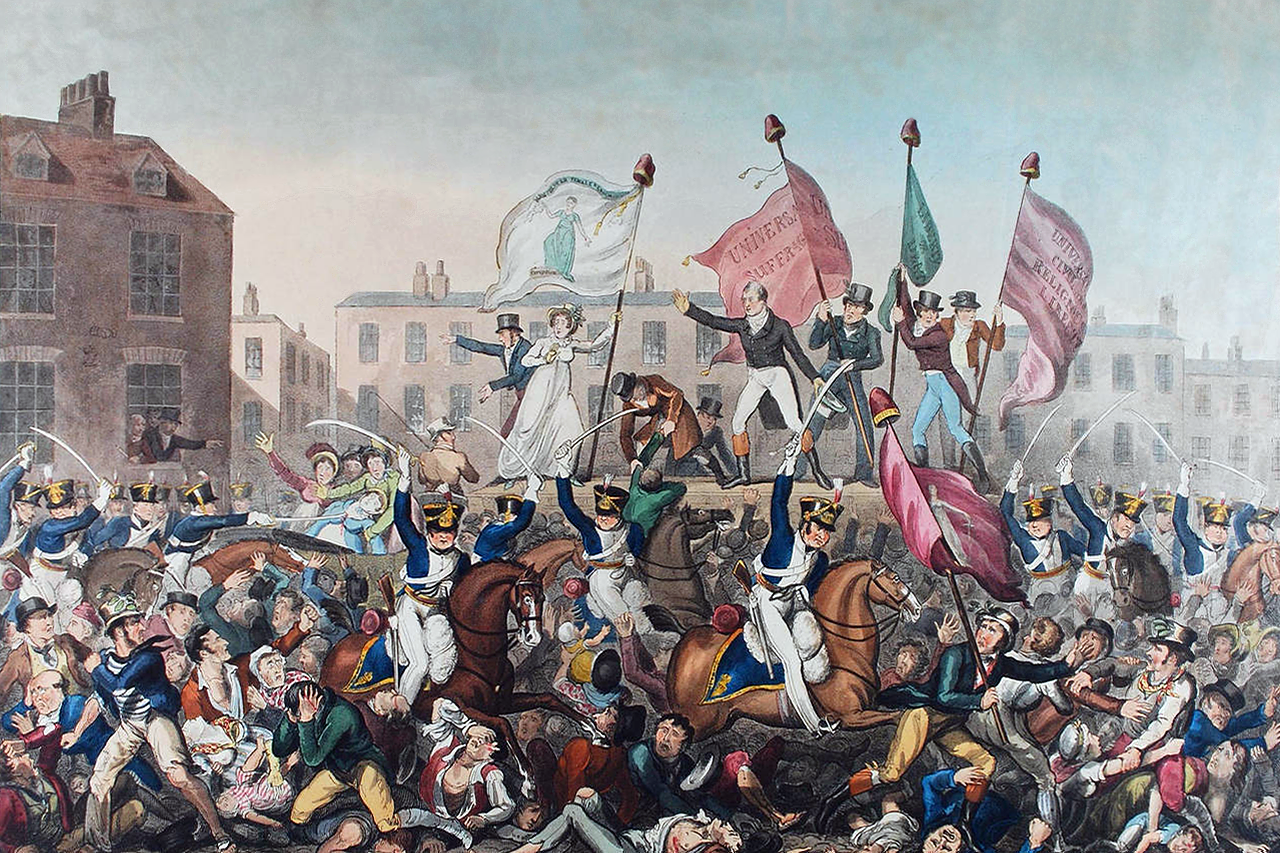
Massacres have provided subject matter for art historically. A few examples are most notable;
1908 - The Third of May, painting by Goya,
Background: https://en.wikipedia.org/wiki/The_Third_of_May_1808
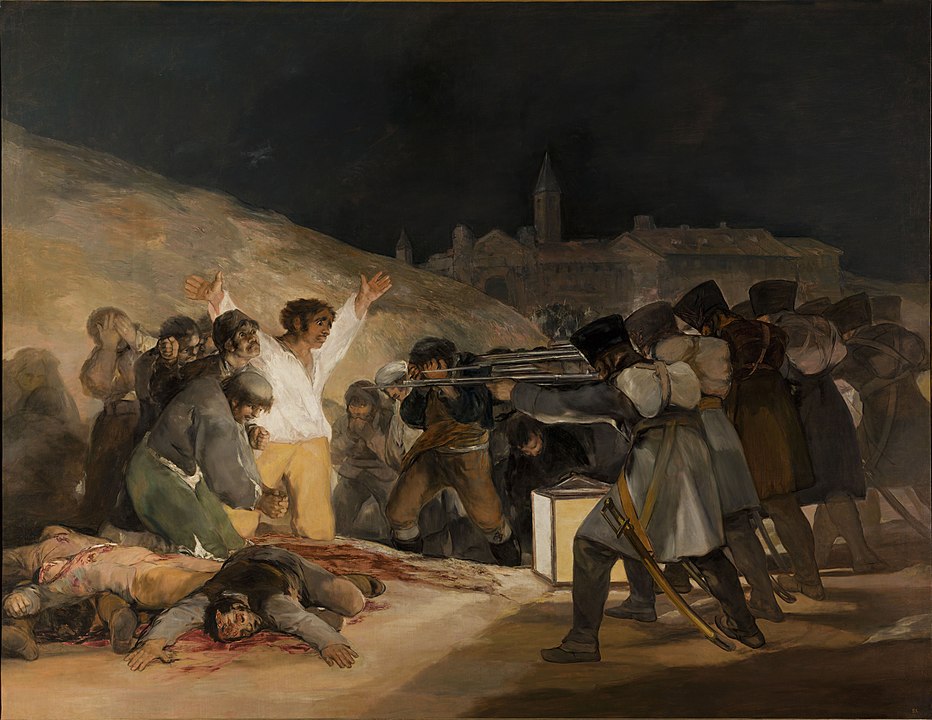
public domain
1916 - Easter, 1916 by W. B. Yeats
Background on the poem: https://en.wikipedia.org/wiki/Easter,_1916
Poem by Yeats: https://www.poetryfoundation.org/poems/43289/easter-1916
image: (wikipedia, public domain)
.jpg)
1937 - Guernica, painting by Pablo Picasso
Background on the painting: https://en.wikipedia.org/wiki/Guernica_(Picasso)
Painting: No free license. Visit: https://en.wikipedia.org/wiki/Guernica_(Picasso)#/media/File:PicassoGuernica.jpg
This was a bombng of the town of Guernica requested by Generalissimo France. Those bombed by the Nazi Luftwaffe were Spanish Nationalists and Basque government people. Historians view it as the art of the begining of air terror against civilians for the purpose of demoralization.
Babi Yar - poem by Yevgeny Yevtushenko
Background: https://en.wikipedia.org/wiki/Babi_Yar
In this massacre in 1941, more than 33,000 Jews were killed by Nazis in the Ukraine.
Poem by Yevtoshenko and background: https://remember.org/witness/babiyar
Mass burial site:
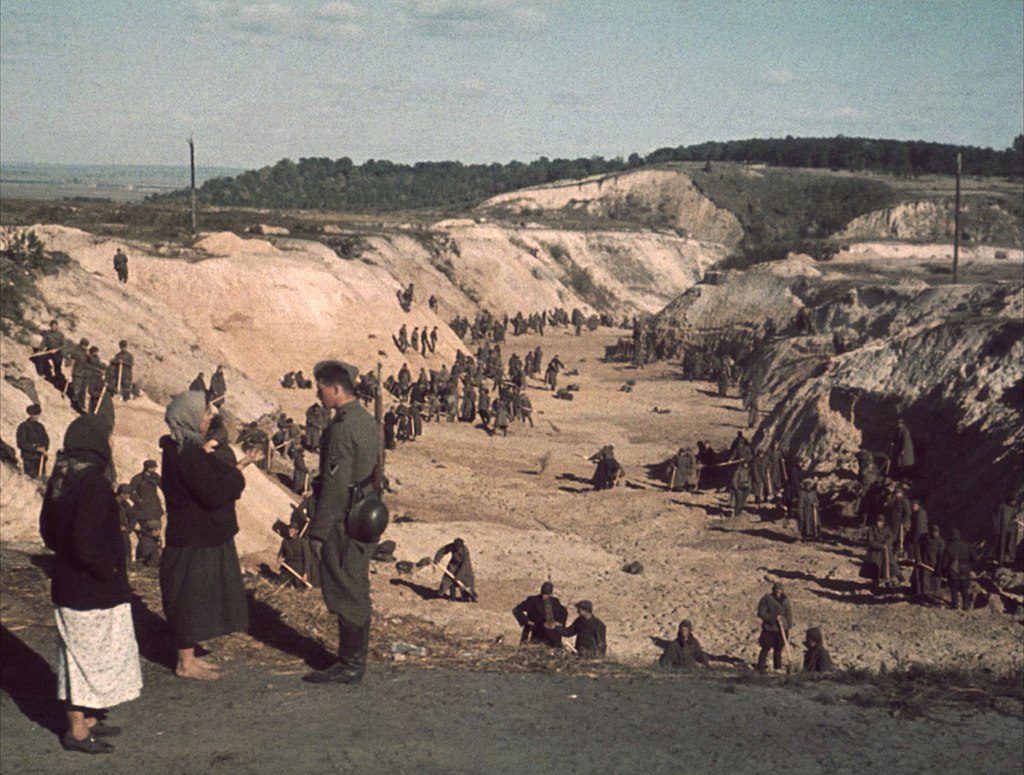
1840 A.D. - Advent of Women's Rights in the United States
LUCRETIA MOTT, a founder of the American Women's
Rights Movement

photo credit: public domain from en.wikipedia.org
| 1840
Learn more at https://www.en.wikipedia.org/wiki/Lucretia_Mott |
1848
Seneca Falls Convention - a milestone in Women's Rights.
See
https://en.wikipedia.org/wiki/Seneca_Falls_Convention
National Women's Rights Historical Park, Seneca Falls, NY

Photo credit and copyright: Albert Fried-Cassorla
See Albert's video of a trip there at:
https://www.youtube.com/watch?v=3wHsWTKDmYM
National Women's Rights Historical Park, Seneca Falls, NY
[1] https://en.wikipedia.org/wiki/Timeline_of_human_evolution
[2] https://en.wikipedia.org/wiki/Paleolithic
[3] https://en.wikipedia.org/wiki/Lascaux
[4] Western Civilizations, Cole, Symes, Coffin and Stacy, Brief 3rd edition, Vol. , c 2005, p. 4
[5] https://en.wikipedia.org/wiki/Writing#History
[6] https://en.wikipedia.org/wiki/Jewish_history#Ancient_Israelites_.28to_586_BCE.29
[7] https://www.youtube.com/watch?v=OW9x-Z3u2Lo Inside Judaism - Jewish history
[8] https://en.wikipedia.org/wiki/Cleisthenes
[9] Prof. Richard Stewart, Montgomery County Community College, lecture, July 15, 2105
[10] Prof. Richart Stewart, Montgomery County Community College, lecture, July 14, 2105
[11] https://en.wikipedia.org/wiki/Dying_Gaul
[12] https://en.wikipedia.org/wiki/Lascaux
[i] History's Timeline, by Jean Toomer, Ann Kramer, and Theodore Rowland, Crescent Books, 1981, p. 8